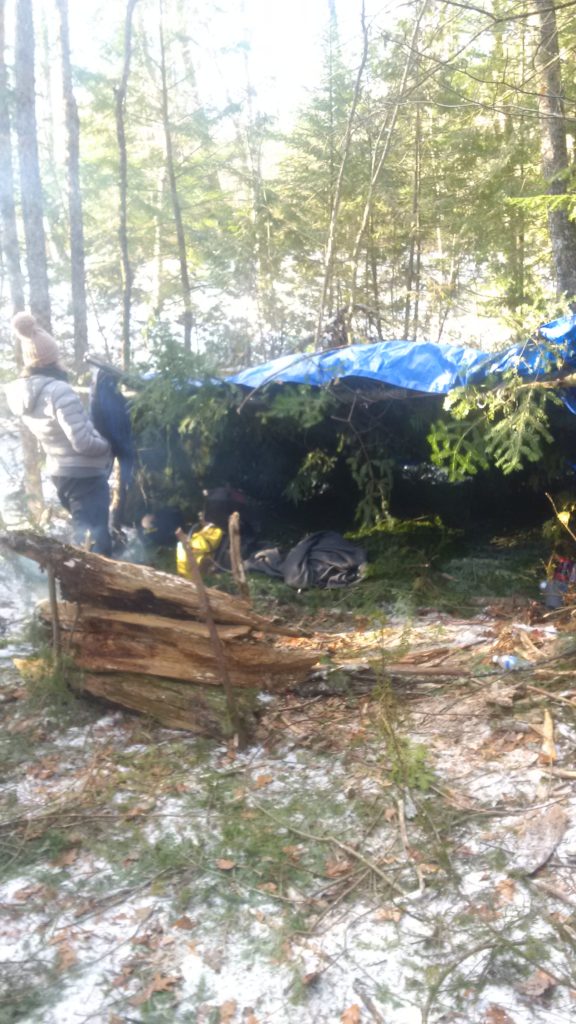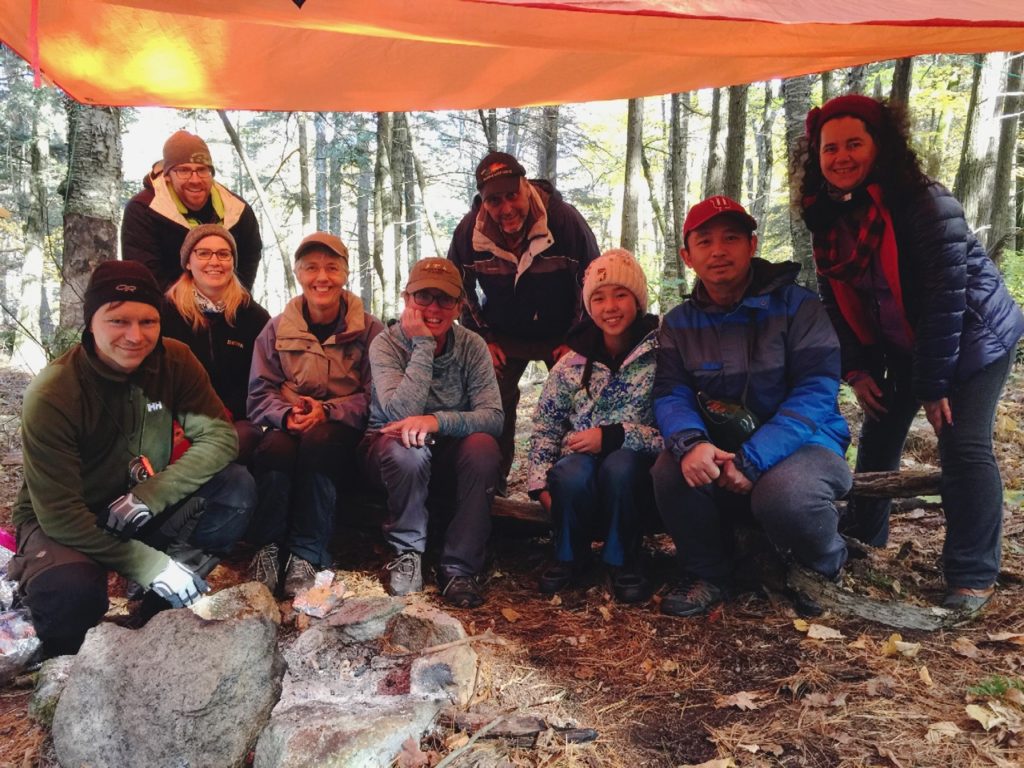During the November 16/17th weekend, WSC Survival School conducted an Outdoor Survival Skills overnight campout course. Ironically, we weren’t expecting extreme winter temperatures and snow conditions that you typically find in January! Saturday night saw the temp hit -18 Celsius. Some of the students slept out in a lean-to shelters that they had constructed (see photos), given less than two hours before nightfall to build (very realistic training since normally, folks lost in the wilds become lost with less than an hour or two of sunlight left). In addition, some chose to survive the night with just a wool blanket, even though they had a backup sub zero sleeping bag just in case. Many of the students were dressed in woolens, and in layers. They kept a large fire going in front of the lean-to, reflecting off of a log reflector wall that they had built (a rock reflector wall is the best since rock radiate and reflects more heat compared to a log wall). The shelter had a log floor topped off with evergreen boughs eg balsam first, white spruce, white pine).

On Sunday morning, we de-briefed the experience. We asked the students to detail what they learned, and how they felt during the frigid night. Surprisingly, they said that they enjoyed the night, and mostly, they were toasty warm and comfortable. We discussed the fact that every year in Canada, winter recreationists perish in these type of conditions, while hunting or skiing or snowmobiling. How does that happen? We all agreed that in winter conditions, critical factors that determine survival include proper winter layered clothing, a well thought out survival & safety kit, the ability to construct a big fire and an effective shelter, good Skills and experience, and decent health and fitness.
In my ten years residing in the North Frontenac Region, I have noticed a lack of all around winter Outdoor Pursuits. There’s no shortage of Snowmobile and ice fishing enthusiasts, however, we rarely see folks snowshoeing, cross country skiing, or winter camping. With all of the local excellent crown lands and amazing parks, eg Bon Echo, Frontenac, I’m perplexed at the lack of these active outdoor pursuits compared to passive winter activities like sledding and ice fishing. Don’t get me wrong, I enjoy snowmobiling, atv’ing and ice fishing, but they don’t give you the same healthy and physical benefits that active outdoor pursuits provide.
Becoming more and more popular is the activity called Glamping. Glamping is luxurious camping, typically in a Yurt or Semi Cabin/Tent structure, complete with woodstove, propane furnace, running water, big screen TV, comfy queen and double sized beds, etc etc. If you’re afraid to try winter camping or survival, give this a try! Some provincial parks and private resorts offer this opportunity.
Winter Shelter-
For short term survival, a-framed and lean-to designs are the easiest shelters to construct. It helps to have a tarp, solar blankets, rope, and a good saw, eg the Boreal Agawa Canyon Saw in highly rated. The key to a good shelter is to understand why you need a shelter, eg conduction, convection, and moisture. So thick bedding and roofing, a sloped roof, and a big fire that’s preferably inside or at the entrance.
Tarp Shelter-
My favourite tarps are the MEC Guide tarps. They have a silicone coating that is somewhat fire resistant, and allows you to have a campfire underneath, and you could also set up a winter tent on one side, fire at the other side. It’s easy to set up, especially if you attach ten foot ropes on each corner, and a-frame the tarp over a laterally suspended rope tied from one tree to another.
Hot Tent-
One of my favourite ways to winter camp is using a hot tent and woodstove combination. The Esker brand is available at Canadian Outdoor Equipment, and in a variety of sizes, eg 2-3 person, 4-5 person etc. They are lightweight, easy to set up, and even when it’s forty below, you can heat up the inside to plus twenty, and cook meals on the stove. They are not cheap, and the combo will set you back $1,300 – $2,000. Another option is the larger prospector tents, that can accommodate ten or more campers, and portable yurt systems.
Winter Expedition Tent-
We use several Eureka and North Face winter dome tents. Other excellent tent brands include Marmot and Mountain Hardware, and some economy MEC tents. I like the K2 Eureka Arctic dome tent, and it’s expensive at $799. Winter tents come with titanium or aluminum poles and pegs, and are heavily reinforced. You’ll also need a Winter sleeping bag with at least a -20 Celsius rating, and a thick core foam or ensolite underpad.
The winter season is typically when we hibernate, and avoid the outdoors. That’s also when many folks eat to much, consume to much, become very passive, lazy, and depressed. Winter Outdoor activities are good for the soul, and provide therapeutic and wellness opportunities.
Why not get out and get active in the scenic winter wilderness that the region offers!
David Arama
Please note: we offer winter group activities for schools, scouts, staffs, and special events.
